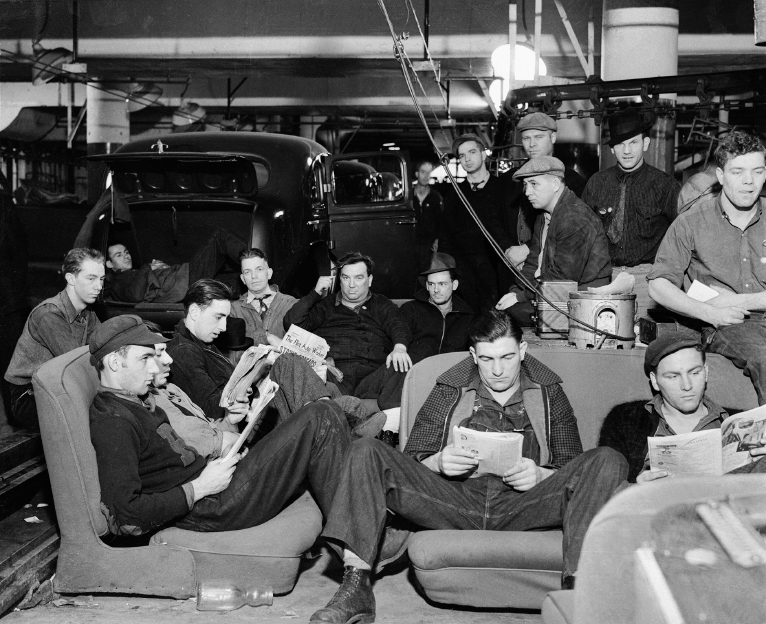America’s History: Printed Page 747
America: A Concise History: Printed Page 678
America’s History: Value Edition: Printed Page 657
The Welfare State Comes into Being
The Revenue Act symbolized the administration’s new outlook. Unlike the First New Deal, which focused on economic recovery, the Second New Deal emphasized social justice and the creation of a safety net: the use of the federal government to assist working people and to provide economic security for the old, the disabled, and the unemployed. The resulting welfare state — a term applied to industrial democracies that adopted various government-guaranteed social-welfare programs — fundamentally changed American society.

The Wagner Act and Social Security The first beneficiary of Roosevelt’s Second New Deal was the labor movement. Section 7(a) of the National Industrial Recovery Act (NIRA) had given workers the right to organize unions, producing a dramatic growth in rank-and-file militancy and leading to a strike wave in 1934. When the Supreme Court voided the NIRA in 1935, labor unions called for new legislation that would allow workers to organize and bargain collectively with employers. Named for its sponsor, Senator Robert F. Wagner of New York, the Wagner Act (1935) upheld the right of industrial workers to join unions. The act outlawed many practices that employers had used to suppress unions, such as firing workers for organizing activities. It also established the National Labor Relations Board (NLRB), a federal agency with the authority to protect workers from employer coercion and to guarantee collective bargaining.
A second initiative, the Social Security Act of 1935, had an equally widespread impact. Other industrialized societies, such as Germany and Britain, had created national old-age pension systems at the turn of the century, but American reformers had failed to secure a similar program in the United States. The Townsend and Long movements now pressed Roosevelt to act, giving political muscle to pension proponents within the administration. Children’s welfare advocates, concerned about the fate of fatherless families, also pressured the president. The resulting Social Security Act had three main provisions: old-age pensions for workers; a joint federal-state system of compensation for unemployed workers; and a program of payments to widowed mothers and the blind, deaf, and disabled. Roosevelt, however, limited the reach of the legislation. Knowing that compulsory pension and unemployment legislation alone would be controversial, he dropped a provision for national health insurance, fearing it would doom the entire bill.
The Social Security Act was a milestone in the creation of an American welfare state. Never before had the federal government assumed such responsibility for the well-being of so many citizens. Social Security, as old-age pensions were known, became one of the most popular government programs in American history. On the other hand, the assistance program for widows and children known as Aid to Dependent Children (ADC) became one of its most controversial measures. ADC covered only 700,000 youngsters in 1939; by 1994, its successor, Aid to Families with Dependent Children (AFDC), enrolled 14.1 million Americans. A minor program during the New Deal, AFDC grew enormously in the 1960s and remained an often maligned cornerstone of the welfare state until it was eliminated under President Clinton in 1996.
New Deal Liberalism The Second New Deal created what historians call New Deal liberalism. Classical liberalism held individual liberty to be the foundation of a democratic society, and the word liberal had traditionally denoted support for free-market policies and weak government. Roosevelt and his advisors, along with intellectuals such as British economist John Maynard Keynes, disagreed. They countered that, to preserve individual liberty, government must assist the needy and guarantee the basic welfare of citizens. This liberal welfare state was opposed by inheritors of the nineteenth-century ideology of laissez-faire capitalism, who gradually became known as conservatives. These two visions of liberty and government — with liberals on one side and conservatives on the other — would shape American politics for the next half century.
COMPARE AND CONTRAST
Question
How did the Second New Deal differ from the first?